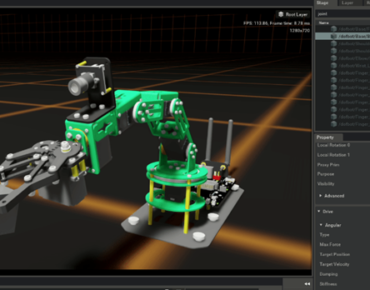Nvidia’s Isaac Sim Robotics Simulation Software Now Available in Free Open Beta Release

As enterprises experiment with AI, machine learning and robotics, one challenge that arises is finding time to test and troubleshoot the actual algorithms, code and hardware in real-world situations such as factory floors without disrupting just-in-time goods production and operations.
That is where Nvidia’s Isaac Sim robotic simulation software can come into play as a virtual 3D environment where a company’s actual facilities can be modeled as a digital twin to allow testing and evaluations to be conducted accurately, away from production environments.
Unveiled as a nascent platform in mid-2018 at the Computex technology conference, Isaac Sim has undergone broad development since then and is now available in open beta, giving companies the ability to use and test the application in their own operations at no charge.
 Isaac Sim runs atop Nvidia’s Omniverse collaboration and simulation platform, providing companies with tools and features that enable the construction of virtual robotic worlds and experiments using synthetic data generation that can mimic real production facilities and their use of AI, ML and robotics.
Isaac Sim runs atop Nvidia’s Omniverse collaboration and simulation platform, providing companies with tools and features that enable the construction of virtual robotic worlds and experiments using synthetic data generation that can mimic real production facilities and their use of AI, ML and robotics.
“In the very beginning, when you are actually developing the robot itself and you want to prototype it, it is much easier to try things out and see how they work when you are in a simulator, before you commit to a physical design,” Gerard Andrews, senior product marketing manager for Nvidia’s robotics developer community, told EnterpriseAI. “If you have AI, it must be trained, you need data to train it. And if you are going to put it in a factory floor, you cannot actually run your real factory and have the robot going around collecting its data to train its AI.”
By using Isaac Sim, enterprises can generate simulated images through a photorealistic simulation environment, which can then be used to train the models, said Andrews.
“That is a huge deal for us,” he said. “You can bootstrap and get that AI training going well before you have access to wherever it will be physically deployed.”
In addition, using the simulator allows users to test the processes where live interactions on factory floors could be dangerous or expensive, he said. This allows testing to see how robots react to vehicles moving down a production line or when they are exposed to humans walking nearby as the robots are moving at the same time.
“You can prove them out in a simulated world with much less hassle and risk than in the real world,” said Andrews.
So far, thousands of developers in hundreds of companies have been using Isaac Sim through an early adopter program. No companies are yet using the system in production.
Named for science and science fiction writer Isaac Asimov, Isaac Sim is designed to allow users to put realistic robot models in compelling environments to visualize and simulate how they will work in the real world, said Andrews.
 By using synthetic, or simulated, images to do the training, major benefits also include lower costs compared to have videographers capture live footage of testing, he said.
By using synthetic, or simulated, images to do the training, major benefits also include lower costs compared to have videographers capture live footage of testing, he said.
“We believe that 3D workflows are important for many industries,” said Andrews. “You know we have a strong history in games, and that is probably some of the heritage that is built into the product, but it has expanded into these other real use cases.”
The Isaac simulation engine is built to streamline synthetic data generation and domain randomization to build datasets built right where the work is being done, or so-called “ground-truth datasets,” according to Nvidia. That data is needed to train robots in applications from logistics and warehouses to factories of the future.
Among the new features of the Nvidia Isaac Sim beta version are multi-camera support, the inclusion of a fisheye camera with synthetic data, Robot Operating System 2 (ROS2) support, improved sensor support, an ultrasonic sensor, a force sensor and custom LiDAR patterns.











